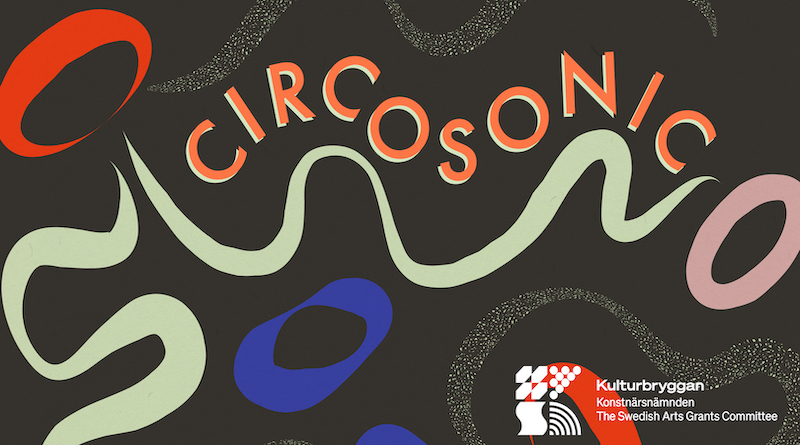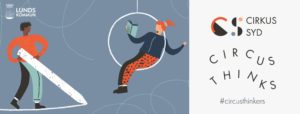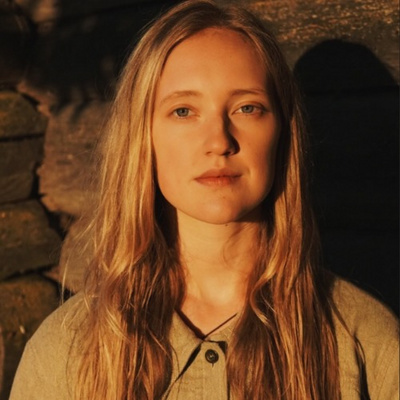The Individual Experience of Sound – Interview with Madeline Hoak

Circosonic is a project by Cirkus Syd, a networking platform for international research, development and innovation based in Lund, Sweden. In the past few months, Circosonic – under the Circus Thinkers Platform – has been exploring circus as sound dimension. Circosonic is an exploration of circus and sound, but that exploration can be hard to share. So the platform decided to share some of their explorations and findings and provide an insight into the project through an interview with our own Madeline Hoak, Associate Editor/Senior Content Producer at CircusTalk, and Circosonic participant.
Alise Bokaldere: In your own words, what is Circosonic?
Madeline Hoak: Circosonic is a pure, untethered exploration of the question: what is contemporary circus and sound, or what is contemporary circus as sound?
I feel those words are interchangeable. What is sound as contemporary circus? What is sound in, with, for – any word you want to insert there – contemporary circus?
The question came about because the sounds of traditional circus feel clearer to us as a community. They feel more common despite our international group of people. Yet contemporary circus was harder to pin down. So it was more of a curiosity. The project approaches the question with complete openness. Anything is game, nothing is wrong, everything is right! Any idea or thought or sub-question that comes with it, we follow until it digresses or disperses, or turns into something else.
The project really is pure research. It draws from the experiences, memories, and expectations of circus and sound from the people involved. Pure research in the way that we have no hypothesis, we have no expectation of where this will go or what it will be. We’re just sitting, generating, absorbing, and responding as we learn and talk together – and that is our answer, no matter how disparate from each other.
We’re not looking for a singular answer; it’s more like the answer will be a mish-mosh of collective experience, just like the material that we’re drawing from, which is our own experience. The end result will end up just as complex as the source material. But hopefully, it will have worked its way through some sort of cycle where it then has more clarity to us, or to you as a viewer or listener. Or, maybe we’re just generating another layer of complex ideas to then be bounced off of in different ways! That’s the best way I can describe it.
AB: And this question about the relationship between circus and sound, was it a question that you had before this project? And if so, how has that changed personally?
MH: As a creator, I’m aware of what sound can do, and what it can be. It certainly isn’t my expertise, the way it is other people’s expertise. As a director, I recognize it as a really important, foundational element of the theatrical circus performative experience, but I had never sat with that question specific to contemporary circus.
How has sound changed through history? What cultural elements am I exposed to that make ‘a contemporary circus sound’ for me? So that’s why this research is very exciting. It is completely out of my wheelhouse and a trajectory that I would not have taken by myself unless prompted. And this was the prompt.
AB: Has it impacted how you work with sound at all?
MH: Not yet. I would say what it’s impacted is how I hear the world.
I’m listening a little bit more. I’m more aware of things that haven’t been brought to my attention before.
If I travel and hear different things, my mind just jumps to the project. Or, I hear an unusual sound, and I think about the project – mostly my upstairs neighbor! All kinds of funny noises come from up there, and they’ve just been part of my life. But now, I’m thinking: is that circus? What is that rhythm?
What it hasn’t done yet – but I know it will – is coalesce in my mind a bit more. I have not taken the musings or reflections from this project into any creative work yet. I am looking forward to that. Once I create an experience at the culmination of this research project, whatever that is, I think I’ll carry the concepts with me quite strongly through other things. Or I’ll seek out people that have more expertise in this and want to collaborate with them. There are so many options.
AB: In that case, how big of a role does sound have in your creations at the moment? What is your focus, if you have a focus on sound?
MH: My current approach feels really boxed in, and I’ve known that for a while about myself and the projects I find myself working on. Because of my dance background, certain pieces of music will hit me, and I immediately see movement. I think, “I’m going to choreograph to this song, or this song has inspired me and it feels like this movement.” That’s a very open avenue in my brain. From playing piano, being a musician through my youth, and participating in musical theater – in all these different ways I have encountered more codified styles of music. But what is exciting about this work is it’s allowing me to stretch my brain more towards noise or sounds that are not necessarily codified as music and see how it will weave its way into my creative life.
AB: You said that the project is making you focus a bit more on noise instead of what you would classify as music. Does that mean that the question “What is sound for contemporary circus” has made you look at sound in a more contemporary way?
MH: The joke I made weeks ago during this project was: my refrigerator is annoyingly loud…is that circus? It impacts my life. It’s having an effect on me. The noises around me have become more highlighted, maybe more performative. They’ve become a larger influence.
Living in New York City, there are obnoxious noises all over, and I wonder, how come these aren’t beautiful noises? When I swipe into the subway there’s a grating, high-pitched beep. How come we have designed our world in this way?
The secondary questions would be: is that circus? Could that be circus? Can I make it circus? What is circus? It has this whole little looping, spiraling, jumping trajectory through those questions.
And especially through conversation with some of the other members, I’ve been thinking more about how much impact sound has on our mood. The project is spilling into life in that way. I’m questioning the sounds and noises around me, or rather, noticing them in a more conscious way.

AB: So what is circus for you right now?
MH: I’m a little attached to this quote from the book Contemporary Circus. Mike Finch described circus as tension, and I really jived with that because it’s invisible. It’s a force.
It’s more of a feeling that can be translated from performer to audience. Within movement, you can create tension, within music there can be tension. It’s an idea about how information is communicated.
Maybe it’s through tension, maybe it’s through a sudden shift. I see tension as longer and gooey, held in static, whereas a quick shift of something (like the moment an aerialist or acrobat drops) is abrupt. So, maybe circus is tension, maybe it’s abruptness, but it has something to do with how emotions get translated invisibly through the work that we do. I see it as everything that exists around and in-between the actual words, the actual movement, the actual notes, and the more tangible or identifiable things. I think I’ve been thinking about that for some odd years now, but this sound project has brought that more to light in a different way.
AB: In your circus, what’s the role of sound?
MH: Thinking about the elements of performance: is it a duet? Is it movement and sound? Is it sound and light? Is it environment and sound? How many different players are there?
Sound is never secondary in my mind. I think all elements need equal attention, even if one is a little more robust than the others.
In that definition and that description (of tension and abruptness), sound could be THE thing making the circus happen. Or It could be something that supports the other circus elements. It can be the thing pulling or pushing, or creating abruptness or smoothness. (We also have to remember silence as part of all this and how powerful that can be!)
These are hard questions to answer, especially with this group because people bring so many ideas to the conversations. The more we grapple with, dissect, and offer different definitions or ways of thinking about circus, it just gets completely muddled! And then to try to piece it back together and ask the personal question, “What is circus to me? What is sound within that?” I find it really hard to answer because it’s so dependent on the moment. It’s a massive question. There are no boundaries. I find it easier to discuss tiny moments – maybe there’s a definition in that one moment.
AB: When you were describing circus just now, you snapped your fingers when you talked about a drop. I wonder if without trying to, you have sounds in your own perception of circus. Maybe sounds that you can’t really translate, but there is a sound that goes with what you do.
MH: Absolutely. I think sound is innate to movement. Even if a movement is in silence, I think there’s still a sound that we associate with it because everything is vibration. That’s another thing that I’ve been thinking about – if sound is waves and vibrations, then it’s actually everything. Everything in the world is vibrating at a molecular level. Then we’re not surrounded by things. We’re actually surrounded by vibration. Everything is sound in that way. And then we could say that it’s music, it’s rhythm.
AB: What’s the most interesting thought, that you have discovered during the Circosonic meetings?
MH: I don’t remember who first said it, but we were talking about architecture and literal spaces that circus can take place in or that we’ve seen circus in. And then we turned it towards the body and said – well, the body is architecture itself, and no one hears the same thing the same way. It’s not going to literally resonate in them the same way inside different bodies. Just as some people say, Is your blue really the same as my blue? When we look at color are we really actually experiencing the same thing, or have we just learned that that is blue and that is teal?
Sounds are different though because they’re culturally learned. Tones that feel happy to one ear feel completely different to another.
When thinking about the body as architecture I see air fill up the lungs – like the sound comes in and fills up this body and shifts it in a certain way. And imagine just how individual that experience is! There’s no comparison between one human and the next.
I loved that idea – being a vessel and how we hold the sound or noise experience, respond to it, give it back, that we generate vibrations, noise, sound, and response.
AB: For anyone who’s been interesting to come to the public discussions, should they come?
MH: It’s a no-brainer. If you are just a curious human, even if you have nothing to do with circus and nothing to do with sound, each event feels like its own small collective – a group-generated lecture. Just how you might go to a lecture to hear an expert speak because you’re curious about a topic even if you have no background in it – that’s what these sessions feel like to me, except the expertise comes directly from everyone who participates. Everyone’s experience is valid, and everyone’s contribution is valid. It’s a really lovely community that’s very welcoming and open. There are no boundaries to who is welcome or who will benefit from this. Anybody and everybody should come!
.Madeline Hoak is an artist and academic who creates with, through, and about circus. She is an Associate Editor for CircusTalk, an Adjunct Professor of Aerial Arts at Pace University, a member of the American Circus Alliances EDI committee, and the Editor and Curatorial Director of TELEPHONE, an international arts game. Madeline has performed, coached, produced, and choreographed at elite regional and international venues. Her background in dance and physical theater is infiltrated into her coaching and creation style. She is passionate about providing her students holistic circus education that includes physical, historical, and theoretical resources. Madeline initiated the Aerial Acrobatics program at here alma mater, Muhlenberg College, where she taught from 2012 - 2017. She is also a regular contributor to Cirkus Syd’s Circus Thinkers international reading group. Her circus research has been supported by Pace, NYU, and Concordia University. Recent publications include “Teaching the Mind-Body: Integrating Knowledge through Circus Arts’' (with Alisan Funk, Dan Berkley), a chapter in Art as an Agent for Social Change (2020), “expanding in(finite) between,” a multimedia essay in Circus Thinkers: Reflections, 2020, and “Digital Dance & TELEPHONE: A Unique Spectator Experience.” Madeline has presented academic papers at numerous conferences including Circus and it’s Others (UC Davis), the Popular Culture Association, Gallatin (NYU), and McGill University. Madeline earned an MA from Gallatin, New York University’s School of Independent Study, where she designed a Circus Studies curriculum with a focus on spectatorship. --- Interview Conducted by Alise Bokaldere, Cirkus Syd Communications Assistant. This interview was originally published on the Cirkus Syd website in June 2022. The project Circosonic has been made possible with the support of : Kulturbryggan Konstnärsnämnden and The Swedish Arts Grants Committee
.
Editor's Note: At StageLync, an international platform for the performing arts, we celebrate the diversity of our writers' backgrounds. We recognize and support their choice to use either American or British English in their articles, respecting their individual preferences and origins. This policy allows us to embrace a wide range of linguistic expressions, enriching our content and reflecting the global nature of our community.
🎧 Join us on the StageLync Podcast for inspiring stories from the world of performing arts! Tune in to hear from the creative minds who bring magic to life, both onstage and behind the scenes. 🎙️ 👉 Listen now!
